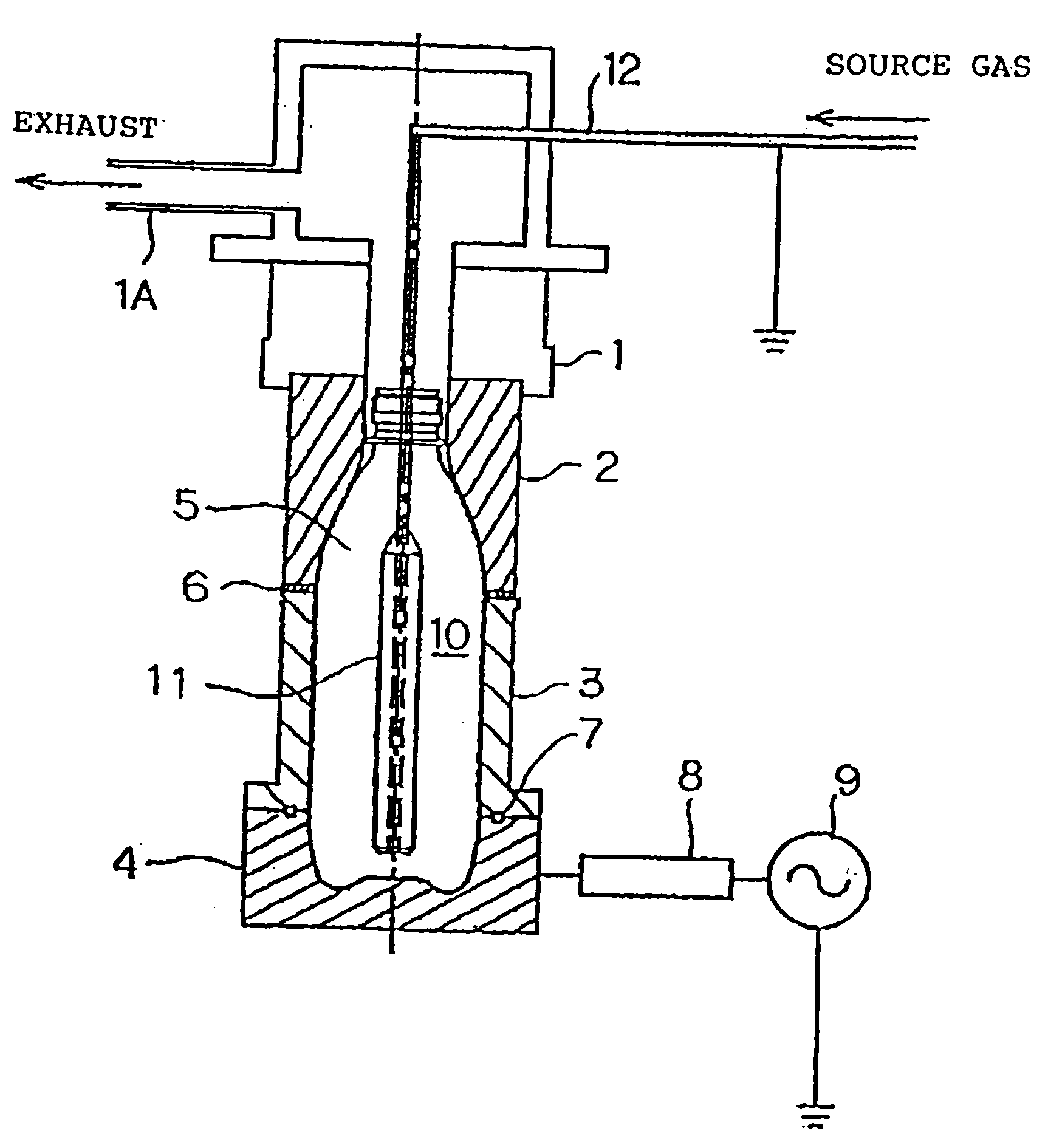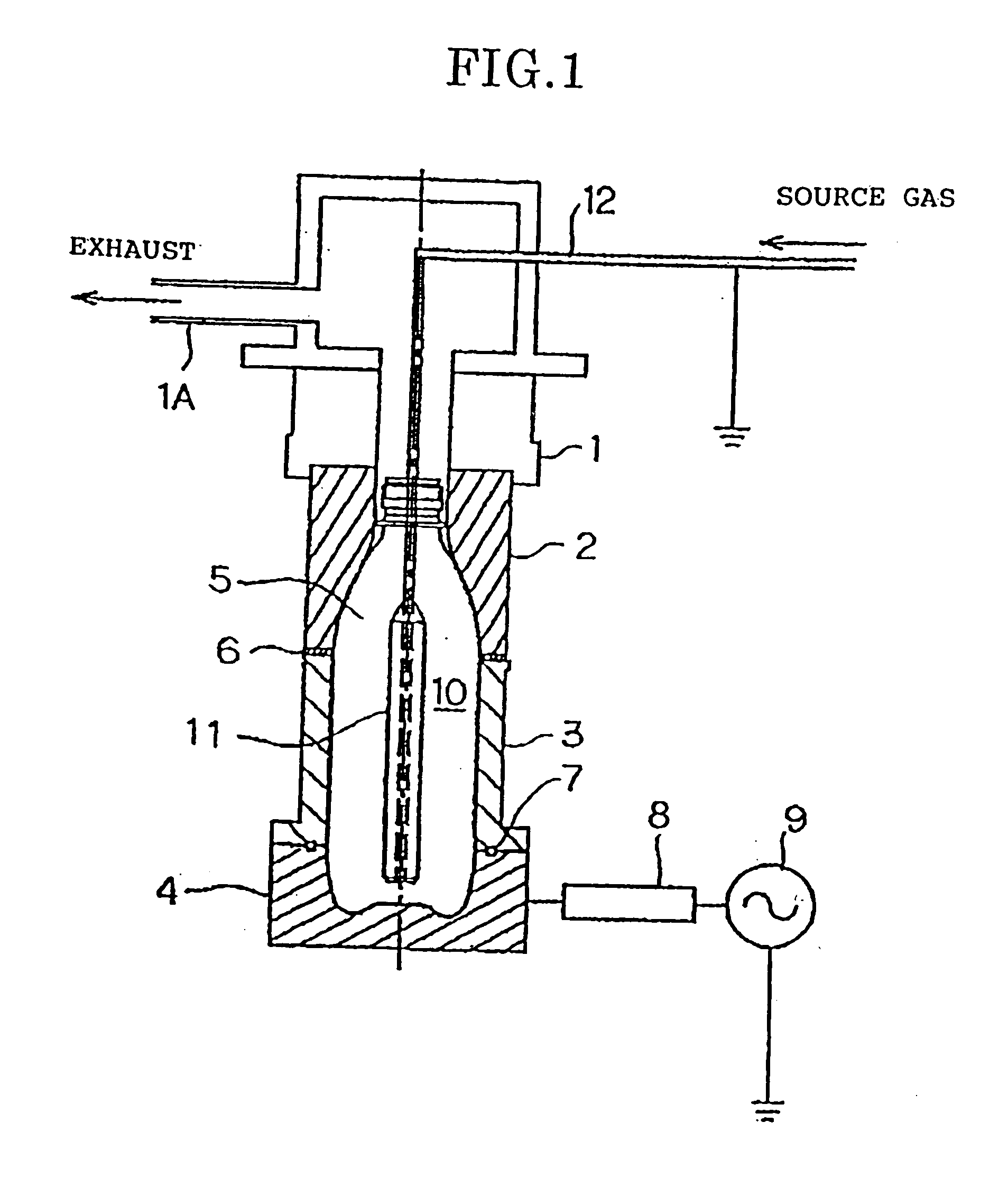Plastic container for liquid medicine
a technology for liquid medicine and containers, applied in the field of plastic containers for liquid medicine, can solve the problems of difficult penetration of nonpolar molecules such as oxygen and carbon dioxide and polar molecules through, and virtually no plastic having properties
- Summary
- Abstract
- Description
- Claims
- Application Information
AI Technical Summary
Benefits of technology
Problems solved by technology
Method used
Image
Examples
example embodiment 1
[0094] Using the apparatus described above, a DLC film was formed on the inner surfaces of a 500 ml PET container with acetylene gas as the source material. Table 1 shows the conditions for forming the DLC film in the present invention. Table 2 shows the various physical properties of the containers depending on the film thickness, density and composition (indicated by the hydrogen content) corresponding to the example embodiments of Table 1. The coating conditions were established as mentioned in Example Embodiment 1 of Table 1. The film thickness, density and composition of Example Embodiment 1 and the physical property values of the film thereof are shown in Table 2.
example embodiments 2
[0095] In the same manner, the film thickness, density and composition of the formed DLC film was changed to establish the example embodiments 2.about.19 of Table 1. The various physical properties of the containers at such time are shown in the same manner in Table 2.
Reference Examples 1.about.13
[0096] DLC films were formed by shifting the conditions of the reference examples from the three conditions of film thickness, density and composition of the DLC films of the example embodiments. The coating conditions were established like the reference examples 1.about.13 of Table 1. The various physical properties of the containers at such time are shown in the same manner in Table 2.
[0097] Blank Space Below
1TABLE 1 Film High-Frequency Forming Gas Flow Hydrogen Example Discharge Electric Power Pressure Rate Thickness Density Atomic Embodiments Method w torr sccm .ANG. g / cm.sup.3 % Example Embodiment 1 Bottom 800 0.05 31 180 1.6 40 Example Embodiment 2 Bottom 800 0.05 31 350 1.6 40 Exampl...
example embodiments recovery percentage example embodiment 22 96.8 example embodiment 23 99.0 example embodiment 24 96.7 example embodiment 25 99.3 example embodiment 26 98.4 example embodiment 27 99.2 reference example 16 94.5 reference example 17 93.6 reference example 18 92.2 (
5 TABLE 5 Example Embodiments Recovery Percentage Example Embodiment 22 96.8 Example Embodiment 23 99.0 Example Embodiment 24 96.7 Example Embodiment 25 99.3 Example Embodiment 26 98.4 Example Embodiment 27 99.2 Reference Example 16 94.5 Reference Example 17 93.6 Reference Example 18 92.2 (Only PET) Reference Example 19 85.8 (Only PP)
EXAMPLE EMBODIMENTS
Adsorption of .gamma.-Globulin
[0113] Adjusted human globulin separated from human blood plasma components is used to treat infectious diseases and the like, but there arises a problem in the case of an injection liquid because of adsorption on the plastic container due to hydrophobic properties. The DLC film coated PET container of the present invention was used to solve this problem.
[0114] In the same manner as the example embodiments (adsorption of insulin), 300 ml of 0.01M phosphoric acid buffer solution having a pH 7.2 was placed in each 500 ml volume plastic container, and then 300 mg of
[0115] .gamma.-globulin was added and disso...
PUM
| Property | Measurement | Unit |
|---|---|---|
| Fraction | aaaaa | aaaaa |
| Fraction | aaaaa | aaaaa |
| Fraction | aaaaa | aaaaa |
Abstract
Description
Claims
Application Information
 Login to View More
Login to View More - R&D
- Intellectual Property
- Life Sciences
- Materials
- Tech Scout
- Unparalleled Data Quality
- Higher Quality Content
- 60% Fewer Hallucinations
Browse by: Latest US Patents, China's latest patents, Technical Efficacy Thesaurus, Application Domain, Technology Topic, Popular Technical Reports.
© 2025 PatSnap. All rights reserved.Legal|Privacy policy|Modern Slavery Act Transparency Statement|Sitemap|About US| Contact US: help@patsnap.com


